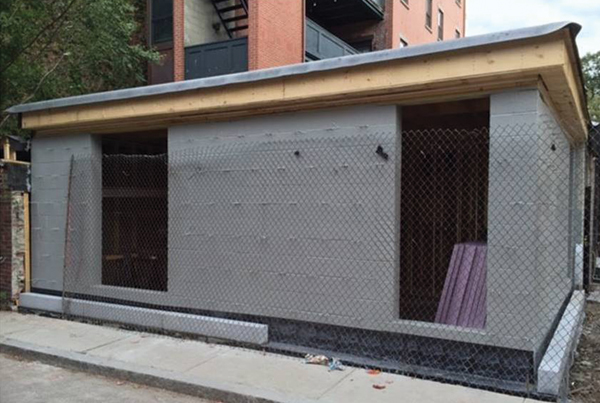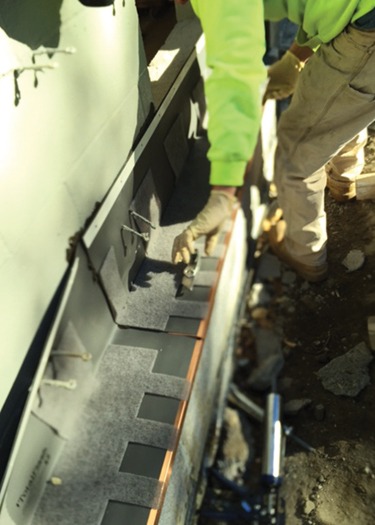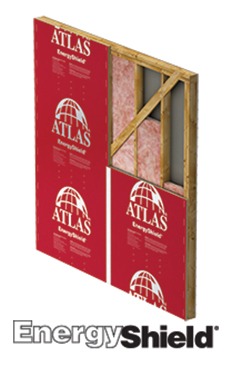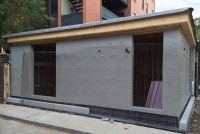December 2015
Building Wraps and Insulation
By Herbert Slone

CMU backup coated with ExoAir 230 fluid applied air/water resistive barrier from Tremco Inc.
In a construction environment challenged by ever-increasing permit and code requirements, one principle remains steadfast: the size of a building project does not necessarily correlate to the complexity of the project. At less than 500 square feet, a recent addition to St. Stephen’s Episcopal Church in Boston ranks among the smallest pro bono projects Cameron Roberts, principal of Cameron Roberts Advisors, has undertaken in a career that spans more than 25 years. Yet, the addition also represents one of the most complex projects Roberts has managed, when viewed through the lens of building envelope codes and permits.
A matrix of code requirements
Tucked into one of Boston’s historic neighborhoods, the St. Stephens Episcopal Church addition presented Roberts with a matrix of requirements, including both aesthetic and building science considerations.
From an aesthetic perspective, the addition’s design needed to complement the existing 19th century architectural style defined by red brick, granite and cornices. Practicality was also a consideration.The vibrant church serves 350 local youths and operates seven days a week, so the site was occupied by staff, congregants and youth program participants throughout the construction phase.
The biggest challenge faced by building professionals working on the addition pertained to the building envelope – specifically to specifying a two-hour rated exterior masonry wall assembly that could meet all of the code provisions in an urban setting subject to a great deal of permitting. Beyond complying with structural requirements, the building envelope was subject to NFPA 285, energy code requirements for insulation in the walls, implementation of a waterproofing system and air infiltration requirements.
“We were faced with a matrix of requirements that needed to be met simultaneously,” Roberts says.
After researching multiple component manufacturers, Roberts considered retaining a building envelope consultant to address the challenging code requirements. He had engaged building envelope consultants in the past and was ready to go the consultant route again, when he came across an article about CavityComplete Wall Systems by Owens Corning in a trade magazine.
“The CavityComplete Wall System was a revelation,” he says, adding that the wall system complied with all of the codes that the St. Stephen’s addition was required to meet. Another challenge was checked off the list, and the addition was one step closer to getting started.
A system-driven approach to wall assemblies

Introduced in 2014, CavityComplete Wall Systems, masonry veneer over steel stud, wood stud or concrete masonry unit (CMU) backup, allow architects to easily specify and detail high-performance assemblies with components that are tested, proven and fully documented to be completely compatible, code compliant and warrantied (see limited warranty at www.CavityComplete.com) to perform together. The wall system components were tested and found to be fully compatible with each other in each system.
While providing building professionals with a solution for addressing complex code environments, the CavityComplete Wall System was also developed to save architects and specifiers time and minimize the risk for errors and omissions. The system brings together components from Owens Corning Sales, Heckmann Building Products, Mortar Net Solutions, Rodenhouse, and Tremco.
The system meets a real need for architects specifying wall assemblies, says Roberts. “Wall technology is the most challenging frontier in building design,” he says. But he is not surprised that a manufacturer developed the systems-based approach to wall assembly, noting that historically manufacturers have led the way in terms of addressing code compliance while the design community has typically not been involved in addressing the issues.
“Over the past 10 years, we’ve seen that manufacturers are typically the first responders when it comes to getting ahead of the code system,” he says.
Building confidence into the job
Of course, specifying a building’s wall assembly is only part of the project. The assembly also needs to be properly installed. For more than 45 years, Leo Laliberte, owner of Laliberte Construction Associates Inc. in Kingston, Mass., has served as a contractor in both the residential and commercial sector along with specializing in structural repair work.
Laliberte embraced the complex code challenges presented by the St. Stephen’s addition.

“I like taking on the challenging jobs no one else likes to do,” he says.
Moisture control – specifically avoiding water infiltration in the walls – was a consideration that Laliberte was particularly interested in addressing. St. Stephens is located next to a high-rise apartment and water run-off issues have arisen in the past.
“Storms and humidity are a big problem in New England, and protecting against moisture infiltration can prevent a lot of maintance problems in the future,” he says, recalling the period in the 1980s, when some builders insulated extensively and then wrapped walls in plastic before putting up the sheet rock and plaster, allowing moisture to build up.
“That was a nightmare,” he recalls. The St. Stephen’s addition was the first time Laliberte’s company had used the CavityComplete Wall System, and he said the system was easy to install. “Once you learn the proper steps, it’s very easy to work with and apply, and it’s especially comforting to know that once the job is done, you don’t have to worry about moisture infiltration.”
Architects also encounter questions during the building process and Roberts praises the technical support and warranty backing the systemized wall approach.
“The completely compatible warranty is new,” he says. “Normally, architects are dependent on consultants to tell them what component might be causing the problem. The CavityComplete warranty covers all of the components in the wall system, and it is backed up by a team of technical experts. There’s no need to figure out which component expert to consult when it comes to warranty questions. And, technical expertise is crucial when it comes to maintaining credibility on site.”
Assurance and confidence for building owners
While CavityComplete is a wall system that helps building professionals specify systems confidently, Laliberte says the sytem also offers assurance to building occupants by reducing the maintenance costs associated with water damage and reducing energy costs (actual savings vary). In addition to dealing with humidity in the Northeast, the CavityComplete Wall System is well suited to the southern climate as it helps walls retain less humidity, which in turn helps a building’s air conditioning system operate more efficiently.
Herbert Slone has worked as an architect, building code official, and teacher of codes and standards in the Kent State University College of Architecture and Environmental Design. He currently is chief architect and manager of commercial building systems for Owens Corning. He has more than 40 years in construction and 30 years in the insulation industry.
NOTE: |
| As Masonry was going to press, the addition at St. Stephen’s was being completed, and both Roberts and Laliberte are excited about making the additional space available to the church staff and those it serves. Moving forward, they see an opportunity for the building industry to support more systemized solutions. |
Product WatchEnergyShield Wall Insulation |
 Appropriate wall insulation for residential and commercial buildings keeps interiors temperate and comfortable, regardless of exterior weather conditions. Basically, this entails keeping cold air out/warm air in during the winter, and cool air in/warm air out during the summer. A well-insulated building provides year-round comfort, cutting cooling and heating bills by up to 40 percent or 50 percent. In turn, this helps reduce the carbon footprint of the building. Appropriate wall insulation for residential and commercial buildings keeps interiors temperate and comfortable, regardless of exterior weather conditions. Basically, this entails keeping cold air out/warm air in during the winter, and cool air in/warm air out during the summer. A well-insulated building provides year-round comfort, cutting cooling and heating bills by up to 40 percent or 50 percent. In turn, this helps reduce the carbon footprint of the building.
Properly insulating the roofs, walls and (in some cases) floors helps meet these overarching goals. Whether a home or a commercial structure, deciding what with and how to sufficiently insulate a building depends on many factors, including where the building project is located and what types of building materials are used. Climates vary throughout the nation, which means different areas will have unique climate and weather conditions that will dictate how to properly insulate the building. Wall insulation’s crucial roleUsing wall insulation is a key component in designing and constructing an energy-efficient building. While it can be retrofitted to existing buildings, the most efficient time to install wall insulation is during construction. Builders and contractors have a variety of options when choosing wall insulation. One of the most energy-efficient and cost-effective ways to insulate walls is with continuous wall insulation (CI). As the name implies, CI is continuous across all structural members, and can be installed on the interior (certain issues apply) or exterior of the building envelope. This method can provide an air and vapor barrier, drainage plane, and potentially high R-values. Benefits of CIOne of the biggest benefits of CI is that it provides an uninterrupted thermal barrier over an entire opaque wall, not just in wall cavities between studs. Without CI, thermal energy or heat bypasses the batt insulation and moves through the “thermal shorts” of the wall studs. Think of CI as a thermal blanket for a building’s walls, one that can reduce air loss and can act as a weather-resistant barrier beneath the cladding, if it is installed to do so. As a leader in the wall insulation manufacture industry, Atlas offers wall CI products to suit many types of projects, including its EnergyShield Wall Insulation series. Atlas’ EnergyShield wall insulation is made of closed-cell polyisocyanurate (polyiso) foam core, faced in the front with reflective foil, and in the back with a non-reflective facer. Walls sheathed with EnergyShield achieve high R-value and water resistance, making this rigid foam insulation suitable for a variety of CI applications. It can create a water-resistant barrier that prevents liquid moisture (usually from rain) that has breached the exterior wall cladding from continuing into the exterior wall, thus preventing damage. To insure high performance from the water resistant barrier, during installation all boards must have their joints taped or sealed to a joining board and appropriate flashing must be used for rough window and door openings. Atlas recommends sealing into rough opening flashing and to other portions of the building, including the roof and below grade. Each Atlas EnergyShield CI product has specific instructions for use, including conditions of use, examination of board requirements, and preparation of boards, all of which are provided in the installation guides. When constructed correctly, the continuous barrier envelops all structural components and surfaces. It provides a continuous “seal,” which offers superior insulating properties. This polices air and moisture transfer. Using CI allows the temperatures inside the wall cavity to rise, resulting in a drier interior. Any moisture that does leak in, whether during construction and installation, or later because of leaks or water-related damage, is able to dry out. |
